|
Chapter One
IN SEARCH OF
PARADISE
May I remind the reader that the following pages are excerpts only.
"There was a time - our ancient scriptures tell us - when
Immortality was within the grasp of Mankind.
"A golden age it was, when
Man lived with his Creator in the Garden
of Eden - Man tending the wonderful orchard, God taking strolls in
the afternoon breeze.
"And the Lord God caused to grow from the
ground every tree that is pleasant to the sight and good for eating,
and the Tree of Life was in the orchard, and the Tree of Knowing
good and evil. And a river went out of Eden to water the garden, and
from there it was parted and became four principal streams: the name
of the first is Pishon ... and of the second Gihon ... and of the
third Tigris ... and the fourth river is the Euphrates."
"Of the fruit of every tree were Adam and Eve permitted to eat -
except of the Tree of Knowing. But once they did (tempted by the
Serpent) - the Lord God grew concerned over the matter of
Immortality:
Then did the Lord Yahweh say:
Behold, the Adam has become as one of us
to know good and evil;
And now might he not put forth his hand
and partake also of the Tree of Life,
and eat, and live forever?
"And the Lord Yahweh expelled the Adam
from the Garden of Eden ...
And he placed at the east of the Garden of Eden
the Cherubim, and the Flaming Sword which revolveth,
to guard the way to the Tree of Life.
"So was Man cast out of the very place where eternal life was within
his grasp. But though barred from it, he has never ceased to
remember it, to yearn for it, and to try to reach for it.
"Ever since that expulsion from Paradise, heroes have gone to the
ends of Earth in search for Immortality; a selected few were given a
glimpse of it; and simple folk claimed to have chanced upon it.
Throughout the ages, the
Search for Paradise was the realm of the individual; but earlier in
this millennium, it was launched as the national enterprise of
mighty kingdoms.
"The New World was discovered -
so we have been led to believe -
when explorers went seeking a new, maritime route to India and her
wealth.
"No sooner had Columbus and his men set foot in what they all
thought were the islands off India ("The West Indies"), than they
combined the exploration of the new lands with a search for the
legendary Fountain whose waters "made old men young again." Captured
Indians were questioned, even tortured, by the Spaniards, so that
they would reveal the secret location of the fountain.
"....
Titan’s Love Sacred and Love Profane, was created at about the
time the Spaniards were in their quest in the Indies. As everyone
well knew, the Fountain in the paintings hinted at the ultimate
lovemaking, the Fountain whose waters make possible "all manly
performances" through Eternal Youth.
" .... Many researchers, such as
Ponce de Leon’s Fountain of Youth:
History of a Geographical Myth by Leonardo Olschki, have established
that "the Fountain of Youth" was the most popular and characteristic
expression of the emotion and expectations which agitated the
conquerors of the New World. Undoubtedly, Ferdinand the king of
Spain was one of those so agitated, so expectant for the definite
news.
" .... In March 1513, Ponce de Leon set out northward, to look for
the island of Bimini. The public excuse for the expedition was a
search for "gold and other metals"; the true aim was to find the
Fountain of Eternal Youth. This the seamen soon learnt as they came
upon not one island but hundreds of islands in the Bahamas....They
drank waters of endless springs" (sailing along Florida’s coast, as
Ponce de Leon named it), " but none seemed to work the expected
miracle.
" .... The mission’s failure appears to have hardly dampened the
conviction that the Fountain was undoubtedly there: it only had to
be discovered.
".... The conviction that the Fountain existed somewhere on the
islands was so strong that in 1514 - the year after Ponce de Leon’s
unfruitful mission - Peter Martyr (in his Second Decade) informed
Pope Leo X....
".... In 1521, the Spanish Crown sent
Ponce de Leon on a renewed
search, this time focusing on Florida. There can be no doubt
regarding the true purpose of his mission: writing only a few
decades later the Spanish historian Antonio de Herrera y Tordecillas
stated this in his "Historia General de las Indias": He, (Ponce de
Leon) went seeking that Sacred Fountain, so renowned among the
Indians, as well as the river whose waters rejuvenated the aged. He
was intent on finding the spring of Bimini and the river in Florida,
of which the Indians of Cuba and Hispaniola "affirmed that old
persons bathing themselves in them became young again."
"Instead of Eternal Youth,
Ponce de Leon found death by an Indian
arrow.
".... The Holy Scriptures, pagan beliefs, and the documented tales
of great travellers, all combined to affirm that there was indeed a
place whose waters (or fruit’s nectar) could bestow Immortality by
keeping one forever young.
Mr. Sitchin proceeds by explaining the tales from the
Celts, Greeks,
Romans, segments from the Koran about a tale about
Moses, where a
dead fish on falling on certain waters, in the "junction of the two
streams" got its life back and swam away.
Moses tales from the
Koran were interchanged by popular belief with
Alexander the Great, and Alexander remains from his first mentioning
to the end of this chapter as the main character searching for the
Fountain of Youth. He travels to numerous places and encounters numerous beings.
Passing to next chapter, there is a recount of Alexander’s
adventures in his short lived life.
|
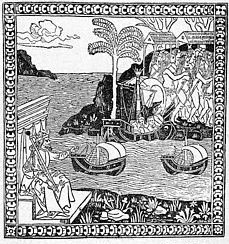
Columbus
Lands on New World. |
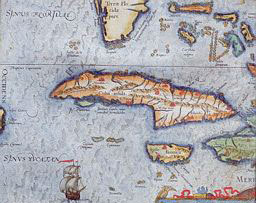
WEST INDIES
|
|
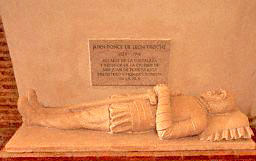
TOMB OF
PONCE DE LEON
|
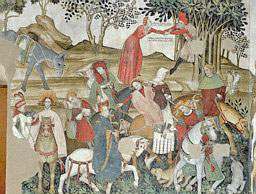
Italian
Fresco, celebrating "After Bathing in the Fountain of
Youth" |
|
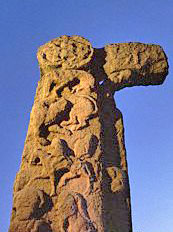
Ancient
Celtic Cross in the Inner Hebrides |

Ancient
Greek Galleons
|
|

The Appian
Way built by early Romans |
|
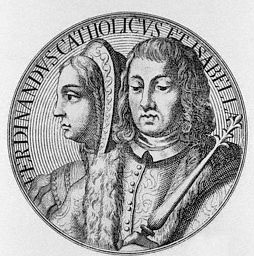
King
Ferdinand and Queen Isabella of Aragon |
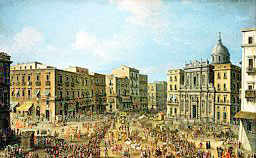
King
Ferdinand Entourage in Naples
|
|

The Bahamas
|

Florida |
|

Ponce de
Leon searched for the Fountain of Youth in The Bahamas
and Florida |
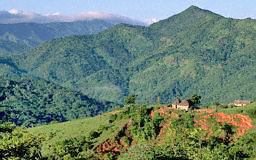
Cuba
(Hispaniola) another place for the search of the
Fountain of Youth |
|
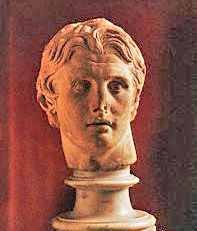
Alexander
The Great. Bust from Istambul |

Alexander
The Great in Battle with Darius III
He also searched for the Fountain of Youth
|
Return
Chapter Two
THE
IMMORTAL ANCESTORS
"The short life of
Alexander the Macedonian - he died at age
thirty-three in Babylon - was filled with conquest, adventure,
exploration; a burning desire to reach the Ends of Earth, to unravel
divine mysteries.
"It was not an aimless search. Son of
Queen Olympias and presumably
of her husband King Philip II, he was tutored by the philosopher
Aristotle in all manner of ancient wisdom. Then he witnessed
quarreling and divorce between his parents, leading to the flight of
his mother with the young Alexander. There was reconciliation, then
murder; the assassination of Philip led to the crowning of Alexander
when twenty years old. His early military expeditions brought him to
Delphi, sit of the renowned oracle. There he heard the first of
several prophecies predicting for him fame - but a very short life.
"Undaunted Alexander set out - as the Spaniards did nearly 1,800
years later - to find the Waters of Life. To do so, he had to open
the way to the East. It was from there that the gods had come: the
great Zeus.... Aphrodite.... Poseidon.... Athena, who carried to
Greece the olive tree from the lands of western Asia. There, too,
according to the Greek historians, whose writings Alexander studied,
were the Waters which kept one for ever young."
The tales which enriched
Alexander’s life are many, and several were
the personalities he met.
"Was the episode of the Cave of the Gods - as the other episodes in
the history of Alexander - pure fiction, mere myth, or perhaps
embelished tales based on historical fact?
"Was there a
Queen Candace, a royal city named Shamar, a world
conqueror named Sesonchusis? In truth, the names meant little to
students of antiquity until relatively recently. If these were names
of Egyptian royal personages or of a mystical province of Egypt,
they were as obscured by time as the monuments were obscured by the
encroaching sands; rising above the sands, the pyramids and the
Sphinx only broadened the enigma; the hieroglyphic picture-words,
undecipherable, only confirmed that there were secrets not to be
unlocked. The tales from antiquity , passed on via the Greeks and
Romans, dissolved into legends; eventually, they faded into
obscurity"
"It was only when Napoleon conquered Egypt in 1798, that Europe
began to rediscover Egypt....Then, near the village of
Rosetta.... The key was found to unlock the language and inscriptions
of ancient Egypt: its records of Pharaonic feats, the glorifications
of its gods.
"There indeed was a Queen Candace. The hieroglyphic inscriptions
(discovered later between 1912 and 1914) revealed, that at the very
beginning of the Nubian kingdom, it was ruled by a wise and
benevolent queen. Her name was Candace.... And further south of
Meroe, within this kingdom’s domain, there was a city named
Sennar -
possibly the Shamar referred to in the Alexander tale."
Sesonchusis, was known by various names, "Kosh" "Senusert" "Sesostris."
"Sesonchusis did indeed exist. His Egyptian name meant "He whose
births live." For, by virtue of being a Pharaoh of Egypt, he had
every right to join the company of the gods, and live forever.
"The authors or editors of the histories of Alexander relate various
incidents in which Alexander encountered Sesonchusis;
Elijah and
Enoch, or just Enoch. The incident of Sesonchusis could only be
guessed, and the manner of his translation to Immortality is not
described. Not so with Elijah - the companion of Enoch in the
Shining Temple, according to one Alexander version."
".... Of him, the Scriptures say that he did not die on Earth, for
he "went up into heaven in a whirlwind....
And it came to pass when the Lord
would take up Elijah into Heaven by a Whirlwind,
that Elijah went with Elisha from Gilgal.
And Elijah said unto Elisha:
"Tarry here, I pray thee,
for the Lord has sent me to Beth-El."
And Elisha said unto him:
"As the Lord liveth, and by thy life,
I will not leave thee."
So they went down to Beth-El.
"And the sons of the prophets that were at Beth-El
came forth to Elisha, and said unto him:
"Knowest thou that the Lord will, this day,
take the master from above thee?"
And he said: "Yes I know it too, but keep silent."
As Elijah and
Elisha, who always refused to part from his master,
approached the Jordan, plus other 50 disciples who stopped and stood
apart,
"And Elijah took his mantle
and rolled it together,
and struck the waters.
And the waters parted hither and thither,
and the two of them crossed over on dry ground.
"Once they were across,
Elisha asked that Elijah imbue him with the
divine spirit; but before he could get an answer,
"As they continued to walk on and to talk,
there appeared a chariot of fire,
and horses of fire, and the two were separated.
And Elijah went up into Heaven,
in a Whirlwind.
And Elisha saw,
and he cried out:
"My father! My father!
The Chariot of Israel and its horsemen!"
and he saw it no more."
" .... The encounter with
Enoch, which the histories of Alexander
claimed for him, introduced into the Search for Immortality an
"Immortal Ancestor" specifically mentioned in the Old and New
Testaments alike, the legends of whose ascent to the heavens
predated the Bible and were recorded in their own right."
Besides other writings which
Mr. Sitchin mentions at this point in
his book, there are:
" .... Various Christian writings throughout the centuries also
contained similar hints or references, and as it turned out, there
have in fact circulated since the second century B.C.
several
versions of a Book of Enoch. When the manuscripts were studied in
the nineteenth century, scholars concluded that there were basically
two sources. The first, identified as I Enoch and called the
Ethiopic Book of Enoch, is an Ethiopic translation of a previous
Greek translation of an original work in Hebrew (or Aramaic). The
other, identified as II Enoch, is a Slavonic translation from an
original written in Greek whose full title was The Book of the
Secrets of Enoch.
Here the story of the
ascension of Enoch to Heaven is told, the
encounter with the two beings who took him in their wings and placed
him on the clouds and the clouds moved.
In the First Heaven he saw a very great sea, greater than the
earthly sea.
The Second, was a gloomy Heaven.
In the
Third Heaven "he was shown a garden with a goodliness of its
appearance; beautiful and fragrant trees and fruits.
"In the midst therein there is a Tree of Life - in that place on
which the God rests when he comes into Paradise.
"Going further up, to the
Fourth Heaven, Enoch could see the
Luminaries and various wondrous creatures, and the Host of the Lord.
"In the Fifth Heaven he saw many "hosts."
"In the Sixth, "bands of angels who study the revolutions of the
stars."
"Then he reached the Seventh Heaven, where the greatest angels
hurried about and where he saw the Lord - "from afar" - sitting on
his throne.
"The two winged men and their moving cloud placed
Enoch at the
limits of the Seventh Heaven, and left, whereupon the Lord sent the
archangel Gabriel to fetch Enoch into his presence.
"Written both as a personal testament and as a historic review, the
Ethiopic Book of Enoch, whose earliest title was probably
The Words
of Enoch, describes his journeys to Heaven as well as to the four
corners of Earth.
"...."towards the north ends of Earth," he "saw there a great and
glorious device.".... "And he saw there, as well as at the western
ends of Earth, "three portals of heaven open in the heaven" in each
place, through which hail and snow, cold and frost blew in.
"And hence I went to the south to the ends of the Earth, "and
through the portals of Heaven there blow in the dew and rain. And
thence he went to see the eastern portals, through which the stars
of Heaven pass and run their course.
"But the principal mysteries, and secrets of the past and the
future, were shown to Enoch as he went to "the middle of the Earth,"
and to the east and to the west thereof. The "middle of the Earth"
was the site of the future Holy Temple in Jerusalem; on his journey
east, Enoch reached the Tree of Knowledge; and going west, he was
shown the Tree of Life.
After many other stories about his travels and learning at the
Heavenly Abode, Enoch was transported back to Earth to do some
teaching, in hiding.
"But when the Deluge neared, he wrote down his teachings and advised
his great-grandson Noah to be righteous and worthy of salvation.
"After that, Enoch was once again, "raised aloft from among those
who dwell on Earth. He was raised aloft on the Chariot of the
Spirits, and his ’Name’ vanished among them."
Alexander took
part in great battles.... but he also travelled
in Search for the
Water of Life, or Fountain of Youth.
|
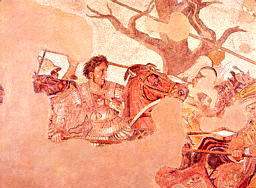
Alexander
fighting Darius or the Persians. A Mosaic from Naples.
|

Aristotle,
teacher of Alexander. |
|
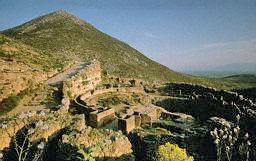
Alexander
came to Delphi....Greece |
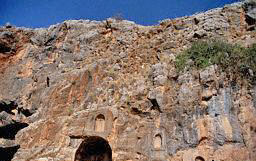
Ancient Cave
of Greek God Pan |
|

It was
Napoleon’s men who discovered ancient records when they
found, in the sand near Rosetta, a Stone Tablet,
"Rosetta," which helped to unravel ancient history,
Egyptian glyphs.... |
 |
|

Findings of
the Nubian Kingdom, Sudan, one of Alexander’s stops.
|
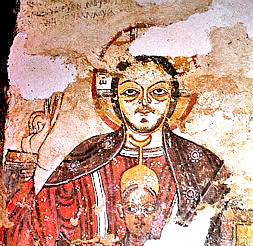
A more
recent discovery, a Coptic Painting of Christ giving
protection to a Nubian Prince |
|
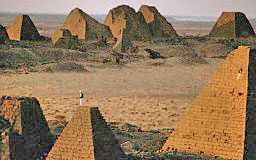
The largest
site of Kush civilization, burial Pyramids in ancient
Meroe; Khartoum, Sudan today. |
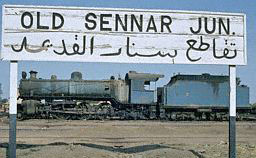
A British
commodity at ancient Sennar, Sudan
. |
|
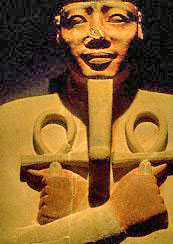 |

Sesostris I,
and Ruins of Sesostris, who appear in Alexdander’s
tales.
|
|
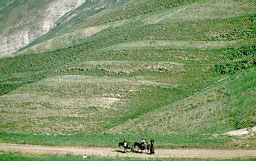
Beth-El,
modern Bethel, above; and Jordan River Valley, below;
,the lands where the epic of Elijah and Elisha occurred.
Alexander’s historian claims Alexander had an encounter
with Elijah when searching for his ancestors.
|
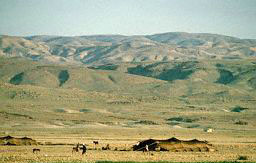
|
Return
Chapter Three
THE PHARAOH’S
JOURNEY TO THE AFTERLIFE
"The adventures of
Alexander and his search for the Immortal
Ancestors clearly comprised elements which simulated their
experiences: caverns, angels, subterranean fires, fiery horses and
Chariots of Fire. But it is equally clear that in the centuries
preceding the Christian era, it was believed (by Alexander or by his
historians or by both) that if one wished to attain Immortality, one
had to emulate the Egyptian Pharaohs.
".... Egyptian traditions held that in times immemorial "Gods of
Heaven" came to Earth from the Celestial Disk (represented by a
winged globe). When Egypt was inundated by waters, "a very great
god who came forth (to Earth) in the earliest times" arrived in
Egypt and literally raised it from under the waters and mud, by
damming the waters of the Nile and undertaking extensive dyking and
land reclamation works (it was therefore that Egypt was nicknamed
"The Raised Land"). This olden god was named PTAH - "The Developer."
He was considered to have been a great scientist, a master engineer
and architect, the chief Craftsman of the gods, who even had a hand
in creating and shaping Man. His staff was frequently depicted as a
graduated stick - very much like the graduated rod which surveyors
employ for field measuring nowadays."
"The Egyptians believed that
Ptah eventually retired south, where he
could continue to control the waters of the Nile with sluices he had
installed in a secret cavern, located at the first cataract of the
Nile (the site of today’s Aswan Dam). But before leaving Egypt, he
built its first hallowed city and named it AN, in honor of the
God
of the Heavens (the biblical On, whom the Greeks called
Heliopolis).
There he installed as Egypt’s first Divine ruler his own son
RA (so
named in honor of the Celestial Globe).
"Ra, a great "God of Heaven and Earth," caused a special shrine to
be built at An; it housed the Ben-Ben - a "secret object" in which
Ra had purportedly come down to Earth from the heavens.
"In time
Ra divided the kingdom between the gods OSIRIS and
SETH.
But the sharing of the kingdom between the two divine brothers "did
not work."
"... The place of Osiris on the throne of Egypt was taken over by
his son HORUS.
" .... Growing up, Horus challenged
Seth for the throne. The
struggle ranged far and wide, the gods pursuing each other in the
skies. Horus attacked Seth from a Nar, a term which in the ancient
Near East meant "Fiery Pillar".... Depictions from pre-dynastic
showed this celestial chariot as a long, cylindrical object with a
funnel-like tail and a bulkhead from which rays are spewed out, a
kind of a celestial submarine. In front the Nar had two headlights
or "eyes," which according to the Egyptian tales changed color from
blue to red.
The battle ends with Seth losing his testicles, and
Horus losing an
eye.
"The great gods called a truce and met in council. After some
wavering and indecision, the Lord of Earth ruled in favor of giving
the throne of Egypt to Horus, declaring him the legitimate heir in
the Ra-Osiris line of succession. Thereafter, Horus was usually
depicted with the attributes of a falcon, while Seth was shown as an
Asiatic deity, symbolized by the ass, the burden animal of the
nomads.
Kingship was established then in the
Two Lands (Upper and Lower
Egypt) for its perpetual divine connection,
"For every Pharaoh was deemed a successor of
Horus and the occupier
of the throne of Osiris.
After a period of chaos and decline:
" .... Finally, circa 3200 B.C., a "dynastic race" arrived in Egypt
and a man named Menes ascended the throne of a reunited Egypt. It
was then that the gods granted Egypt civilization and what we now
call Religion. The kingship that was begun by
Menes continued
through twenty-six dynasties of Pharaohs until the Persian
domination in 525 B.C., and then through Greek and Roman times (when
the famed Cleopatra reigned).
Mr. Sitchin explains the circle of gods and god-like Pharaohs that
Alexander longed to join. Among them "AMEN "The Hidden One" the very
god Ammon whom Alexander had searched out as his true divine father.
As supreme deity he was worshipped as Amen-Ra, "The Hidden Ra"; and
it is not clear whether he was the very same Ra but now somehow
unseen or "hidden," or another deity."
" .... The belief was that
Ra and the other immortal gods managed to
live forever because he kept rejuvenating itself. Accordingly, the
Pharaohs bore names meaning, for example, "He Who Repeats Births"
and "Repeater of Births." The gods rejuvenated themselves by
partaking of divine food and beverage at their abode.
" .... The ancient incantations appealed to the gods to share with
the deceased king their divine food...."And more specifically, as in
a text for the pyramid of King Pepi:
Give thou sustenance to this King Pepi
From thy eternal sustenance;
Thy everlasting beveredge.
"The departed Pharaoh hoped to draw his everlasting sustenance in
the celestial realm of Ra, on the "Imperishable Star," there grew
the "Plant of Life."
" .... As supreme ruler of the Two Lands of Egypt, he enjoyed the
best possible life on Earth; and the resurrection among the gods was
an even more attractive prospect. Besides, it was only his earthly
body that was to be embalmed and entombed. For the Egyptians
believed that every person possessed a Ba akin to what we call
"soul," which rose heavenward like a bird after death; and a
Ka -
variable translated Double, Ancestral Spirit, Essence, Personality -
through which from the Pharaoh was translated into his Afterlife.
Samuel Mercer, in his introduction to the Pyramid Texts, concluded
that the Ka stood for mortal’s personification of a god. In other
words, the concept implied the existence in Man of a divine element,
a celestial or godly Double who could resume life in the Afterlife.
Mr. Sitchin then explains the long and challenging road the departed
king had to traverse, and the elaborated ceremonial preparations.
" ... The thousands of verses that make up the
Pyramid Texts seem
just to be a collection of repetitious, unconnected incantations,
appeals to the gods or exaltations of the king. To make some sense
of the material, scholars have developed theories about shifting
theologies in ancient Egypt, a conflict and then a merger between a
"Solar Religion" and a "sky religion," a priesthood of
Ra and one of Osiris, and so on, pointing out that we deal with material that has
been accumulated over millennia.
"The scholars who view the mass of verses as expression, of
primitive mythologies, figments of the imaginations of people who
covered in fear as the wind howled and the thunder roared and called
these phenomena "gods" - the verses remain as puzzling and confusing
as ever. But these verses all scholars agree, were extracted by the
ancient scribes from older and apparently well-organized, cohesive
and comprehensible scriptures.
".... The scholarly theories, however, leave unexplained the magical
aspects of the information offered by these texts.
Bafflingly, an Eye of Horus is an object existing independently of
him - an object into whose insides the king can enter, and which can
change hues to blue and red as it is "powered." There exist
self-propelled ferries, doors that open by themselves, unseen gods
whose faces radiate a glow. In the Underworld, supposedly inhabited
by spirits only "bridge girders" and "copper cables" are featured.
And the most baffling aspect of all: Why, if the Pharaoh’s
transfiguration takes him to the Underworld, do the texts claim that
"the king is on his way to Heaven?
"Throughout, the verses indicate that the king is following the
route of the gods, that he is crossing a lake the way a god had
crossed it before, that he uses a barque that the god Ra had used,
that he ascends "equipped as a god" as Osiris was, and so on and on.
And the question arises: what if these texts were not primitive
fantasies - mythology - but accounts of a simulated journey, wherein
the deceased Pharaoh emulated what the gods had actually done? What
if the texts, substituting the name of the king for that of a god,
were copies of some much earlier scriptures that dealt not with the
journeys of the Pharaohs, but with the journeys of the gods?
"One of the leading early Egyptologists,
Gaston Maspero (L’Archeology
Egyptienne and other works), judging by grammatical form and other
evidence, suggested that the Pyramid Texts originated at the very
beginning of Egyptian Civilization, perhaps even before they were
written down hieroglyphically. J.H. Breasted has more recently
concluded (Development of Religion and Thought in ancient Egypt)
that "such older material existed, whether we possess it or not."
"He found in the texts information of civilization and events which
enhances the veracity of the texts as conveyors of factual
information and not of fantasy.
"Taken together, the texts and later illustrations describe a
journey to a realm that begins above ground, that leads underground
and that ends with an opening to the skies through which the gods -
and the kings emulating them - were launched heavenward. Thus the
hieroglyphic connotation combining a subterranean place with a
celestial function.
" .... What, then, if the texts reflect a world which had indeed
existed - what if the Pharaoh’s Journey to Immortality, even if only
by emulation, indeed followed step by step actual journeys
undertaken in prehistoric times?
"Let us follow in these footsteps, let us take the
Route of the
Gods."
|
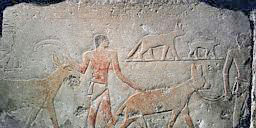
Details from
the tomb of Ptah |
|
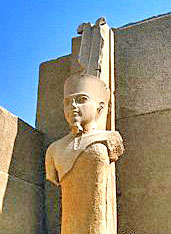
Sculpture at
Temple of Ptah "The Developer."
|

Sesostris
and Ptah, "Chief Craftsman of the gods."
|
|
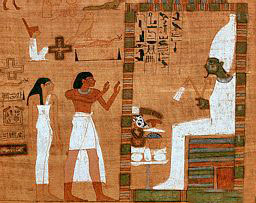
The Dead before Osiris "The Supreme Judge."
.
|
 |
|
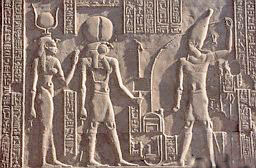
Horus and
Isis, his mother, top. Horus identified as a "Falcon"
from the time he won the Kingdom from Seth, right
|
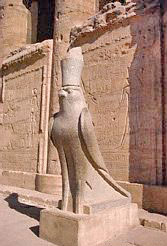 |
|

Later day
Nubian Village in Upper Egypt
.
|

Lower Egypt,
where Cairo stands today, seen from Space. |
|

Details from a temple at Memphis, where the Dynasties of
Pharaohs began with Menes. |
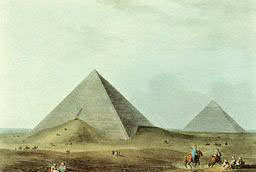
The ancient
Memphis, where the First and Second Pyramids are still
located. Painting by Luigi Mayer
.
|
|
Alexander
had searched "Amen" the very god "Ammon" "The Hidden
One," as his true divine father.
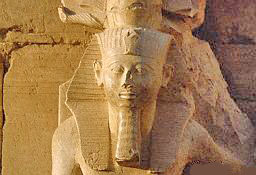
Statue of Amenhotep, of the line of Pharaohs who
worshipped "The Hidden One." |
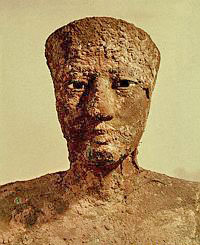
King Pepi I
ascends "The Stairway to Heaven," emulating the gods....
|
Return
Chapter Four
THE STAIRWAY
TO HEAVEN
" .... Having prepared the Pharaoh for his journey, the
Shem priests
now intone the gods to open for the king a path and a gateway. The
divine messenger has arrived on the other side of the false door,
ready to take the Pharaoh through the stone wall and launch him on
his journey."
Crossing the Lake of Reeds
"He descends into the boat, like Ra,
on the shores of the Winding Watercourse.
The king rows in the Hanbu-boat;
He takes the helm toward the
Plain of "The Two that Bring Closer The Heavens,"
in the land beginning from the Lake of Reeds.
Leaving the land of
Horus.... "The eastward place which he seeks to
reach - though under the aegis of Ra - "is in the region of
Seth."
His goal is a mountainous area, the Mountains of the East...."the
two mountains which stand in awe of Seth."
"Finally, the guards of the
Land of Seth let the king proceed toward
a mountain pass. The king’s sponsors make sure that he realizes the
import of the moment:
Thou are now on the way to the high places
In the land of Seth.
In the land of Seth
Thou will be set in the high places,
On that high Tree of the Eastern Sky
On which the gods sit.
"The king has arrived at
the Duat.
"The Duat was conceived as a completely
enclosed Circle of the Gods, at the head-point of which there was an
opening to the
skies (symbolized by the goddess Nut) through which the
Imperishable
Star (symbolized by the Celestial Disk) could be reached.
"The
Duat was divided into twelve divisions, variably described as
fields, plains, walled circles, caverns or halls, beginning above
ground and continuing underground. It took the departed king twelve
hours to journey through this enchanted and awesome realm."
Many details are given in the book as the king passes through the
first division. At the end of which he "encounters other companies
of gods." "Come in peace," they say. He has arrived at the second
division.
" .... Aided by the gods, the king passes safely through the second
division and in the Third Hour arrives at Net-Asar the "Stream of Osiris." Similar in size to the second division, this third division
is inhabited by "The Fighters." It is there that the four gods, who
are in charge of the four cardinal points of the compass, are
stationed.
"The pictorial description which accompanied the hieroglyphic texts
surprisingly showed the Stream of Osiris as meandering its way from
an agricultural area, through a chain of mountains, to where the
stream divided into tributaries. There, watched by the legendary
Phoenix birds, the Stairway to Heaven was situated; there, the
Celestial Boat of Ra depicted as sitting atop of a mountain, or
rising heavenward upon stream of fire.
"Here, the pace of prayers and Utterances increases again, the king
invokes the "magical protectors," that this man of Earth may enter
the Neter-Khert unmolested. The king is nearing the heart of
the Duat; he is near the Amen-Ta, the "Hidden Place...."
May be given to me my Name
in the Great House of Two;
May in the House of Fire
my Name be granted.
In the night of computing years,
and of telling the months,
may I be a Divine Being,
may I sit at the east side of Heaven.
Let the god advance me from behind,
everything in his Name.
"The king is within sight of the "Mountain of Light."
He has reached the STAIRWAY TO HEAVEN.
"The Pyramid Texts said of the place that it was the "stairway in
order to reach the heights." Its stairs were described as "the
stairs to the sky, which are laid down for the king, that he may
ascend thereon to the heavens." The hieroglyphic pictograph for the
Stairway to Heaven was sometimes a single stairway (which was also
cast in gold and worn as a charm), or more often a double stairway,
as a step pyramid. This Stairway to Heaven was constructed by the
gods of the city of An - the location of the principle temple of
Ra
- so that they, the gods, could be "united with the Above."
"The king’s goal is the Celestial Ladder, an
Ascender which would
actually carry him aloft. But to reach it in the House of Fire,
The
Great House of Two, he must enter the Amen-Ta the Hidden Land of Seker, God of the Wilderness.
"....When
Ra himself had arrived at this entrance to the Hidden
Place, "he performed the designs" - followed the procedures - "of
the gods who are therein by means of his voice, without seeing
them." But can the king’s voice alone achieve for him admission? The
texts remind the challenger that only "he who knoweth the plan of
the hidden shaftways which are in the Land of Seker," shall have the
ability to journey through the Place of Underground Passages and eat
the bread of the gods.
"Once again the king offers his credentials. "I am the Bull, a son
of the ancestors of Osiris," he announces. Then the gods who sponsor
him, pronounce in his behalf the crucial words of admission:
Admittance is not refused thee
At the gate of the Duat;
The folding doors of the Mountain of Light
Are opened to thee;
The bolts open to thee of themselves.
Thow treadest the Hall of the Two Truths;
The god who is in it greets thee.
" ....The Pharaoh was admitted into the subterranean world:
"The mouth of the earth opens for thee, the eastern door of heaven
is open for thee," the gods of the Duat announce to the king. He is
reassured that though he enters the mouth of the earth, it is indeed
the Gateway to Heaven, the coveted eastern door.
"The journey in the fourth and following Hours leads the king
through caverns and tunnels where gods of diverse functions are
sometimes seen, sometimes only heard....
".... Mystified and terrified, the king moves on, toward "the
pillars that reach the Heaven."
"The gods seen along the way are mostly organized in groups of
twelve, and bear such epithets as "Gods of the Mountain," "Gods
of the Mountain of the Hidden Land," or "The Holders of
the Time of Life in the Hidden Land."
"The drawings that accompanied some of the ancient texts provide
identification of these gods through the different scepters held by
them, their particular headgear, or by depicting their animal
attributes - hawk-headed, jakal-headed, lion-headed. Serpents also
make an appearance, representing subterranean guards or servants of
the gods in the Hidden Land.
After reading "The Stairway to Heaven" so far, those, like myself,
who have read "The Twelfth Planet," would have already been reminded
of the procedures of the original "gods" Anu, Enlil,
Enki and the
desire of Man to Ascend to Heaven’s abode without "testing death."
For these gods enjoyed long (eternal) life, and possessed the
"Fountain of Youth."
The graphics in the book speak along
Mr. Sitchin’s words, I
recommend then the book, it is a must to view and read, to totally
appreciate the sober meanings.
There are also beautiful recollections of verses about the journey.
As the King (Pepi) continues his way down....
"... The king sees "faceless gods" - gods whose faces cannot be
seen. Offended or simply curious, he pleads with them:
Uncover your faces,
take off your head coverings,
when ye meet me;
For, behold, I [too] am a mighty god
come to be among you.
"But they do not heed his plea to show their faces...."
"Spiraling his way down, the king passes through a door and finds
himself on the third, lowest level. He enters an antechamber which
bears the emblem of the Celestial Disk, and is greeted by the god
who is "The messenger of Heaven" and a goddess who wears the
feathered emblem of Shu, "he who rested the sky upon the
Stairway to
Heaven" as called for by the formula in the Book of the Dead, the
king proclaims:
Hail,
two children of Shu!
Hail,
children of the Place of the Horizon ...
May I ascend?
May I journey forth like Osiris?
"The answer must be positive, for the king is admitted by them...."
".... In the Fifth Hour the Pharaoh reaches the deepest subterranean
parts which are the secret ways of Seker."
It is here that the Pharaoh although not being able to see
Seker,
"the drawings depict the god as a hawk-headed person, standing upon
a serpent and holding two wings within a completely enclosed oval
structure, deep underground, guarded by two sphinxes."
".... The king hears coming from it (the chamber) "a mighty noise,
like that heard in the heights of the heavens when they are
disturbed by a storm...."
Eventually, after much important symbolism is explained by
Mr. Sitchin, the king is finally accepted to proceed:
"Speaking for the
Lord of the Duat, the goddess whose head only was
seen, announced to the Pharaoh the favorable decision: "Come in
peace to the Duat ... advance in thy boat on the road which is in
the earth." Naming herself Ament (the female Hidden One), she added:
"Ament calls to thee, so that thou meyest go forward in the sky, as
the Great One who is in the Horizon."
"Passing the test, not dying a second time, the king was born
again....
".... He rejoins his boat or sled; it is accompanied by a procession
of gods; one of them holds the emblem of the
Tree of Life.
The King has been found worthy of Afterlife."
"Leaving the zone of
Seker, the king enters the sixth division,
associated with Osiris....
".... Jakal-headed gods "Who Open the Ways" invite the king to take
a refreshing dip in the subterranean pool or Lake of Life, as the
Great God himself had done when he passed here before.
"....The king’s boat is towed by gods clad in leopard skins, just as
the Shem priests who performed the Opening of the Mouth ceremonies
were clad.
"Is the king nearing the Opening or Mouth of the Mountain?
"....As the king passes through a guarded gate to the seventh
division, the gods and the surroundings lose their "underground"
aspects and begin to assume celestial affiliations.
".... In this division, there are also present two companies of gods
associated with the Ben-ben the mysterious object of Ra that was
kept at this temple in the city of An (Heliopolis).
"....The king has indeed arrived in parts of
the Duat associated
with An, after whom Heliopolis was named. In the Ninth Hour, he sees
the resting place or the twelve "Divine Rowers of the Boat of Ra,"
they who operate Ra’s celestial "Boat of Millions of Years." In the
Tenth Hour, passing through a gate, the king enters a place astir
with activity. The task of the gods there is to provide Flame and
Fire to the boat of Ra.
"....Passing from the tenth to the eleventh division the
affinity to
the heavens rapidly increases. Gods bear the Celestial Disk and
star
emblems. There are eight goddesses with star emblems "who have come
from the abode of Ra." The king sees the "Star Lady" and the "Star
Lord" and gods whose task it is to provide "power for emerging" from
the Duat, to make the object of Ra advance to the
Hidden House in
the Upper Heavens."
The king now must "shed the skin" and emerge "in the form of a
rejuvenated Ra."
He must wear other garments.
"....The illustrations in the ancient texts depict here a group of
gods dressed in unusual garb, like tightly fitting overalls adorned
with circular collar bands."
"....Having been properly equipped, the king is led to an opening in
the corner of a semi-circular wall. He passes the hidden door. Now
he moves within a tunnel "1300 cubits long called Dawn at the End."
He reaches a vestibule, the emblems of the Winged Disk are seen
everywhere. He encounters goddesses "who shed light upon the road of
Ra," and a magical scepter representing "Seth, the Watcher."
The gods explain to the awed king:
This cavern is the broad hall of Osiris
Wherein the wind is brought;
The north wind, refreshing,
Will raise thee, O king, as Osiris.
"It is now the twelfth division, the final Hour of the king’s
subterranean journey...."The point which he has reached is called
"Mountain of the Ascent of Ra."
"....He has reached an object which is called "The Ascender to the
Sky."
"....The Ascender or Divine Ladder was not a common ladder.
"Illustrations to the Book of the Dead showed such a
Divine Ladder -
sometimes with an Ankh ("Life") sign symbolically reaching toward
the Celestial Disk in the heavens - in the shape of a high tower
with a superstructure....
"....The Ascender was operated by four falcon-men, "Children of Horus" the Falcon-god, who were the sailors of the boat of
Ra....
"....The king’s prayer to be given Everlastingness, a "Name," a
Divine Ladder, has been granted. He is about to begin his actual
ascent to the Heavens.
"Though he requires only one Divine Ladder for himself, not one but
two Ascenders are raised together. Both the "Eye of Ra" and the "Eye
of Horus" are prepared and put into position, one on the "wing of Thoth" and the other on the "wing of Seth." To the puzzled king, the
gods explain that the second boat is for the "son of Aten," a
god
descended of the Winged Disk - perhaps the god to whom the king had
spoken in the "equipping chamber."
"....The "Eye" or "boat" into which the king steps in is 770 cubits
(circa 1000 feet) long.
" ....The magical moment has arrived. There are only two more doors
to be opened, and the king - as Ra and Osiris had done before - will
emerge triumphantly from the Duat and his boat will float in the
Celestial Waters.
"....And suddenly "the double doors to heaven are opened!" The
texts break out in ecstatic pronouncements:
The Door to Heaven is open!
The Door of Earth is open!
The aperture of the celestial windows is open!
The Stairway to Heaven is open;
The Steps of Light are revealed...
The double Doors to Heaven are open;
The double Doors of Khebhu are open
for Horus of the east,
at daybreak.
The sky-god
has strengthened the radiance for the king
that the king may lift himself to Heaven
like the Eye of Ra.
The king is in this Eye of Horus,
where the command of the gods is heard.
"The "Eye of Horus" begins to change hues: first it is blue, then it
is red.
"There are excitement and much activity all around
The gods command to be silent....
"The silence is broken, now there are sound of fury, roaring and
quaking:
"The Heaven speaks, the Earth quakes;
The Earth trembles;
The two districts of the gods shout;
The ground is come apart ...
When the king ascends to heaven
when he ferries over the vault (to Heaven) ...
"Then the "two mountains divide," and there is a
lift-off into a
cloudy sky of dawn from which the stars of night are gone...
".... The "Bull of Heaven" ("whose belly is full of magic") rises
from the "Isle of Flame." Then the agitation ceases, and the king is
aloft - "dawning as a falcon."
"Still sitting between "these two companions who voyage over the
sky," the king soars toward the eastern horizon, far far away in the
heaven. His destination is the Aten the Winged Disk, which is also
called the Imperishable Star:
Ra of the Aten,
Thy son has come to thee;
Pepi comes to thee;
Let him ascend to thee;
Enfold him in thy embrace.
The celestial journey is to last eight days.....the king will be
summoned by Ra.... Ra himself shall await for the king on the
Imperishable Star....
"....’He Who Knows the Place’ comes, say the gods."
"Now there is one more detail left to accomplish. In the company of
"Horus of the Duat," described as "the great green divine falcon,"
the king sets out to find the Tree of Life in the Midst of the Place
of Offering.
"This king Pepi goes to the
Field of Life, the
birthplace of Ra in the heavens. He finds Kebehet approaching him
with these four jars with which she refreshes the heart of the Great
God on the day when he awakes. She refreshes the heart of this
king Pepi therewith to Life.
"Mission achieved.... the King has
ascended the Stairway to Heaven,
he has reached the Imperishable Star; "his lifetime is eternity, its
limit everlastingness."
Return
|









































